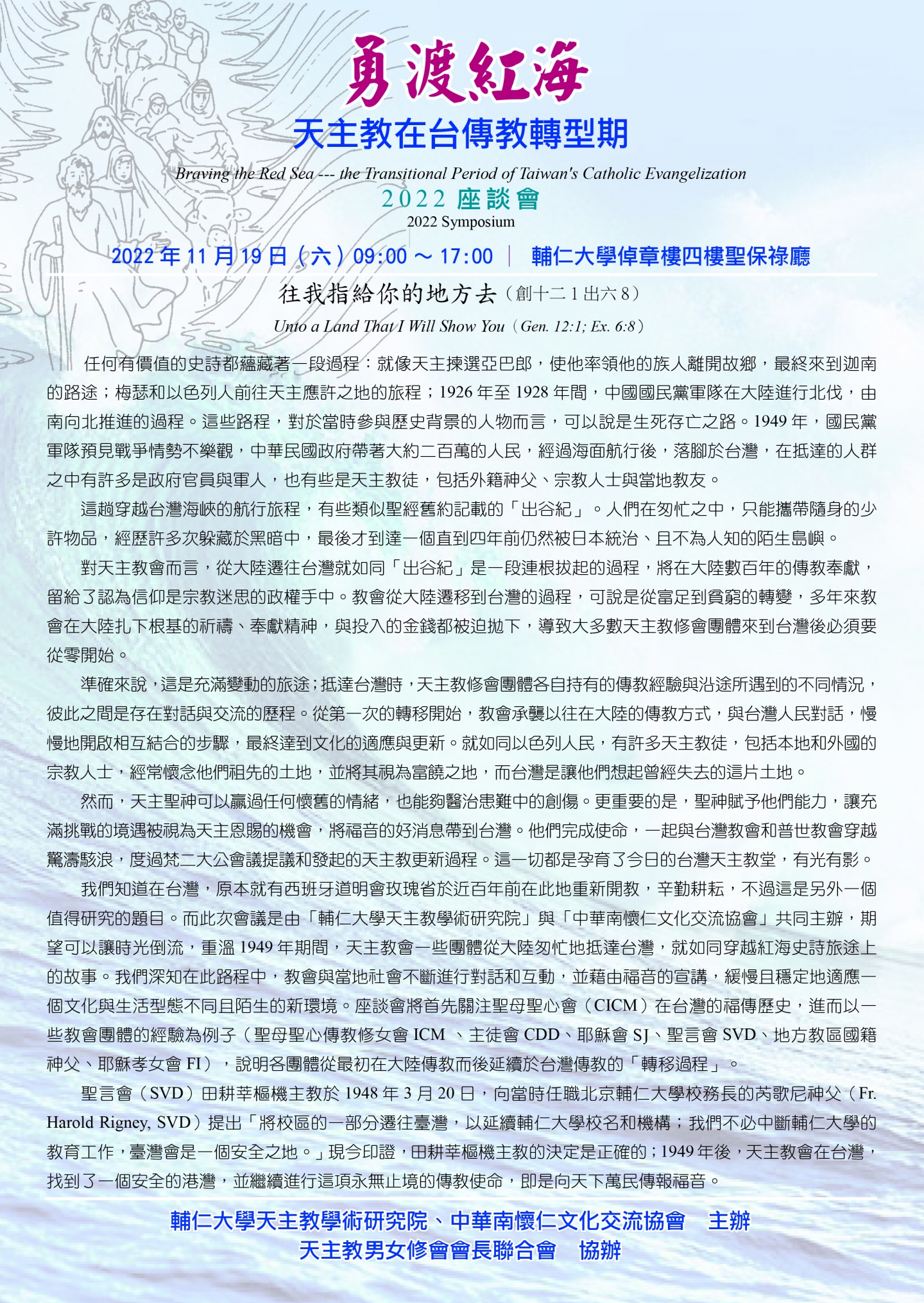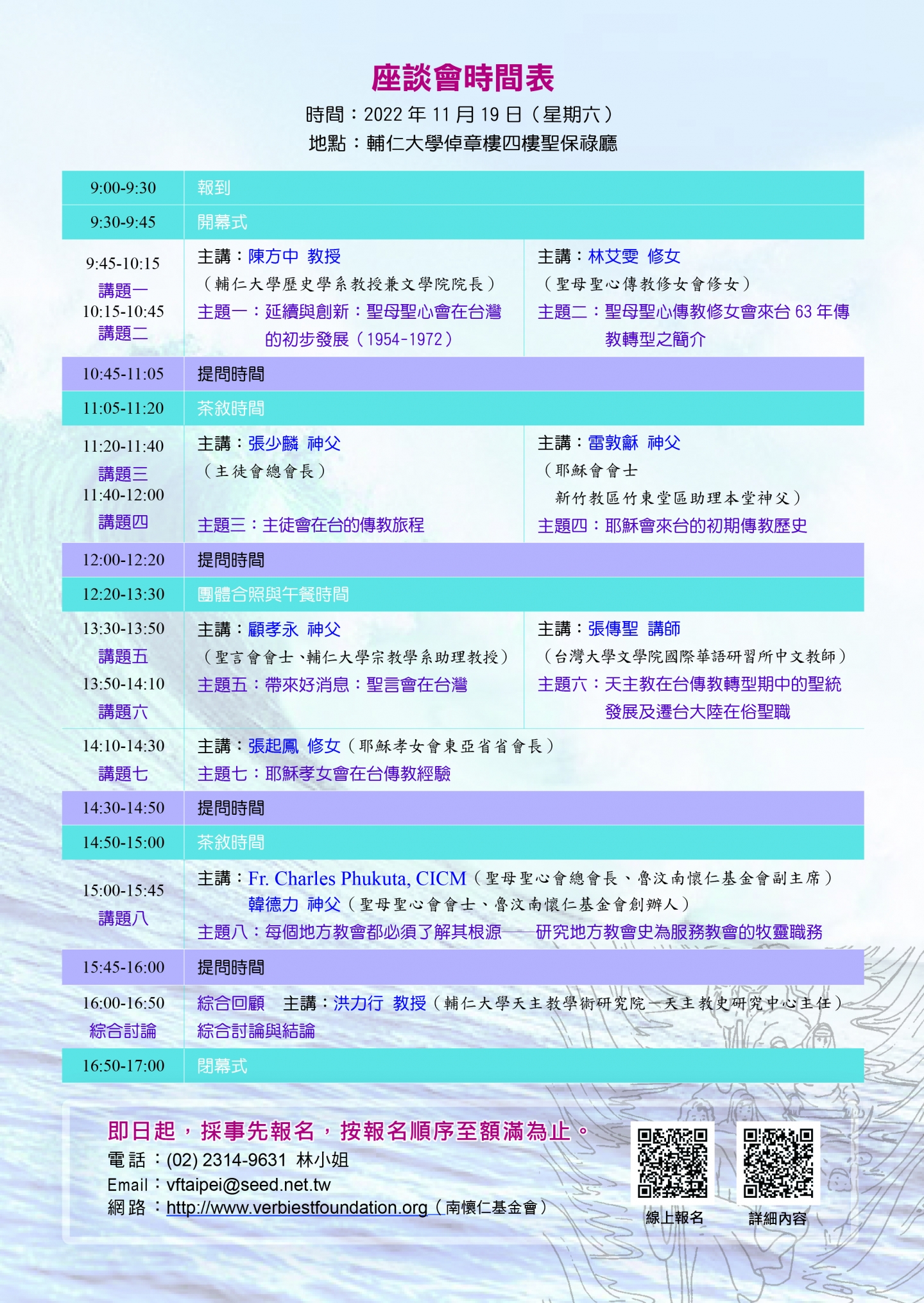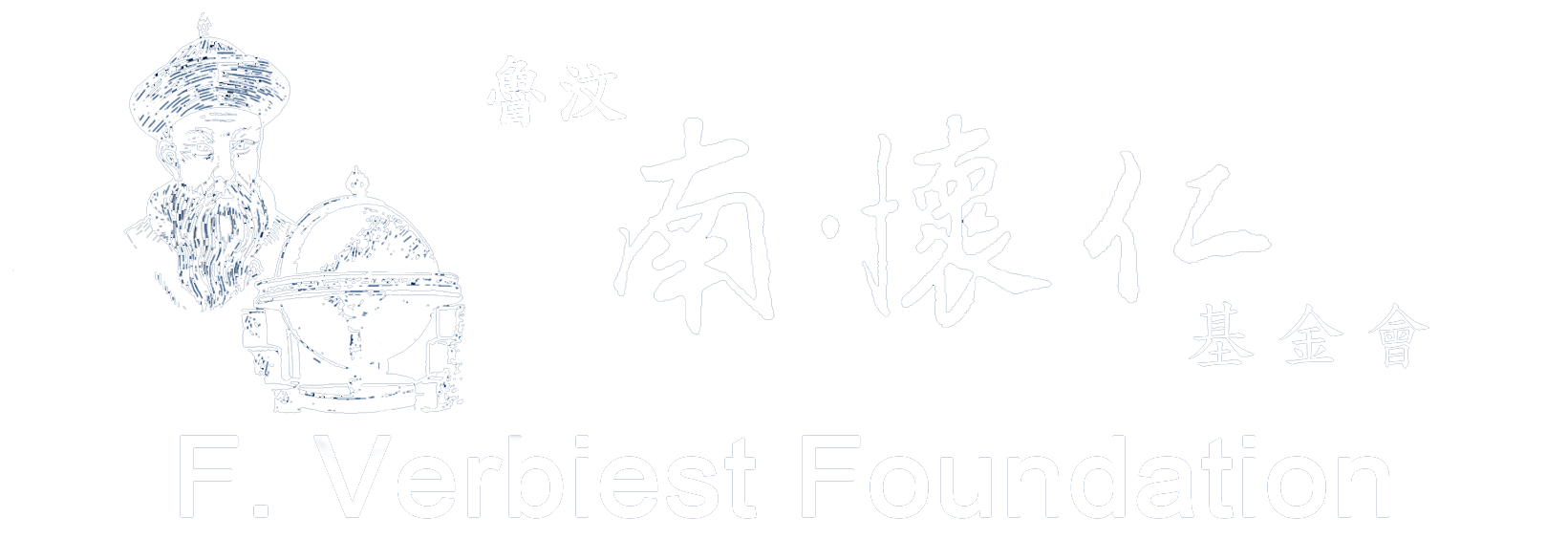輔仁大學天主教學術研究院/中華南懷仁文化交流協會
Braving the Red Sea --- the Transitional Period of Taiwan's Catholic Evangelization
2022 Symposium
勇渡紅海
~天主教在台傳教轉型期~
2022 座談會
Introduction 緣起:
往我指給你的地方去 (創十二1 出六8)
Unto a Land That I Will Show You (Gen. 12:1; Ex. 6:8)
任何有價值的史詩都蘊藏著一段過程:就像天主揀選亞巴郎,使他率領他的族人離開故鄉,最終來到迦南的路途;梅瑟和以色列人前往天主應許之地的旅程;1926年至1928年間,中國國民黨軍隊在大陸進行北伐,由南向北推進的過程。這些路程對於當時參與歷史背景的人物而言,可以說是生死存亡之路。1949年,國民黨軍隊預見戰爭情勢不樂觀,中華民國政府帶著大約二百萬的人民,經過海面航行後,落腳於台灣,在抵達的人群之中有許多是政府官員與軍人,也有些是天主教徒,包括外籍神父、宗教人士與當地教友。
這趟穿越台灣海峽的航行旅程,有些類似聖經舊約記載的「出谷紀」。人們在匆忙之中,只能攜帶隨身的少許物品,經歷許多次躲藏於黑暗中,最後才到達一個直到四年前仍然被日本統治、且不為人知的陌生島嶼。
對天主教會而言,從大陸遷往台灣就如同「出谷紀」是一段連根拔起的過程,將在大陸數百年的傳教奉獻,留給了認為信仰是宗教迷思的政權手中。教會從大陸遷移到台灣的過程,可說是從富足到貧窮的轉變,多年來教會在大陸扎下根基的祈禱、奉獻精神與投入的金錢都被迫拋下,導致大多數天主教修會團體來到台灣後必須要從零開始。
準確來說,這是充滿變動的旅途;抵達台灣時,天主教修會團體各自持有的傳教經驗與沿途所遇到的不同情況,彼此之間是存在對話與交流的歷程。從第一次的轉移開始,教會承襲以往在大陸的傳教方式,與台灣人民對話,慢慢地開啟相互結合的步驟,最終達到文化的適應與更新。就如同以色列人民,有許多天主教徒,包括本地和外國的宗教人士,經常懷念他們祖先的土地,並將其視為富饒之地,而台灣是讓他們想起曾經失去的這片土地。
然而,天主聖神可以贏過任何懷舊的情緒,也能夠醫治患難中的創傷。更重要的是,聖神賦予他們能力,讓充滿挑戰的境遇被視為天主恩賜的機會,將福音的好消息帶到台灣。他們完成使命,一起與台灣教會和普世教會穿越驚濤駭浪,度過梵二大公會議提議和發起的天主教更新過程。這一切都是孕育了今日的台灣天主教堂,有光有影。
我們知道在台灣,原本就有西班牙道明會玫瑰省於近百年前在此地重新開教,辛勤耕耘,不過這是另外一個值得研究的題目。而此次會議是由「輔仁大學天主教學術研究院」與「中華南懷仁文化交流協會」共同主辦,期望可以讓時光倒流,重溫1949年期間,天主教會一些團體從大陸匆忙地抵達台灣,就如同穿越紅海史詩旅途上的故事。我們深知在此路程中,教會與當地社會不斷進行對話和互動,並藉由福音的宣講,緩慢且穩定地適應一個文化與生活型態不同且陌生的新環境。座談會將首先關注聖母聖心會(CICM)在台灣的福傳歷史,進而以一些教會團體的經驗為例子(聖母聖心傳教修女會ICM 、主徒會CDD、耶穌會SJ、聖言會SVD、地方教區國籍神父、耶穌孝女會FI),說明各團體從最初在大陸傳教而後延續於台灣傳教的「轉移過程」。
聖言會(SVD)田耕莘樞機主教於 1948 年 3 月 20 日,向當時任職北京輔仁大學校務長的芮歌尼神父(Fr. Harold Rigney, SVD)提出「將校區的一部分遷往臺灣,以延續輔仁大學校名和機構;我們不必中斷輔仁大學的教育工作,臺灣會是一個安全之地。」現今印證,田耕莘樞機主教的決定是正確的; 1949 年後,天主教會在台灣,找到了一個安全的港灣,並繼續進行這項永無止境的傳教使命,即是向天下萬民傳報福音。
這趟穿越台灣海峽的航行旅程,有些類似聖經舊約記載的「出谷紀」。人們在匆忙之中,只能攜帶隨身的少許物品,經歷許多次躲藏於黑暗中,最後才到達一個直到四年前仍然被日本統治、且不為人知的陌生島嶼。
對天主教會而言,從大陸遷往台灣就如同「出谷紀」是一段連根拔起的過程,將在大陸數百年的傳教奉獻,留給了認為信仰是宗教迷思的政權手中。教會從大陸遷移到台灣的過程,可說是從富足到貧窮的轉變,多年來教會在大陸扎下根基的祈禱、奉獻精神與投入的金錢都被迫拋下,導致大多數天主教修會團體來到台灣後必須要從零開始。
準確來說,這是充滿變動的旅途;抵達台灣時,天主教修會團體各自持有的傳教經驗與沿途所遇到的不同情況,彼此之間是存在對話與交流的歷程。從第一次的轉移開始,教會承襲以往在大陸的傳教方式,與台灣人民對話,慢慢地開啟相互結合的步驟,最終達到文化的適應與更新。就如同以色列人民,有許多天主教徒,包括本地和外國的宗教人士,經常懷念他們祖先的土地,並將其視為富饒之地,而台灣是讓他們想起曾經失去的這片土地。
然而,天主聖神可以贏過任何懷舊的情緒,也能夠醫治患難中的創傷。更重要的是,聖神賦予他們能力,讓充滿挑戰的境遇被視為天主恩賜的機會,將福音的好消息帶到台灣。他們完成使命,一起與台灣教會和普世教會穿越驚濤駭浪,度過梵二大公會議提議和發起的天主教更新過程。這一切都是孕育了今日的台灣天主教堂,有光有影。
我們知道在台灣,原本就有西班牙道明會玫瑰省於近百年前在此地重新開教,辛勤耕耘,不過這是另外一個值得研究的題目。而此次會議是由「輔仁大學天主教學術研究院」與「中華南懷仁文化交流協會」共同主辦,期望可以讓時光倒流,重溫1949年期間,天主教會一些團體從大陸匆忙地抵達台灣,就如同穿越紅海史詩旅途上的故事。我們深知在此路程中,教會與當地社會不斷進行對話和互動,並藉由福音的宣講,緩慢且穩定地適應一個文化與生活型態不同且陌生的新環境。座談會將首先關注聖母聖心會(CICM)在台灣的福傳歷史,進而以一些教會團體的經驗為例子(聖母聖心傳教修女會ICM 、主徒會CDD、耶穌會SJ、聖言會SVD、地方教區國籍神父、耶穌孝女會FI),說明各團體從最初在大陸傳教而後延續於台灣傳教的「轉移過程」。
聖言會(SVD)田耕莘樞機主教於 1948 年 3 月 20 日,向當時任職北京輔仁大學校務長的芮歌尼神父(Fr. Harold Rigney, SVD)提出「將校區的一部分遷往臺灣,以延續輔仁大學校名和機構;我們不必中斷輔仁大學的教育工作,臺灣會是一個安全之地。」現今印證,田耕莘樞機主教的決定是正確的; 1949 年後,天主教會在台灣,找到了一個安全的港灣,並繼續進行這項永無止境的傳教使命,即是向天下萬民傳報福音。
Unto a Land That I Will Show You (Gen. 12:1; Ex. 6:8)
Any worthy epic saga contains a journey, like Abraham in his way to Canaan; from Moses and the Israelites on their way to the promised land, to the Nationalist Army on their Northern Expedition. Those journeys were survival journeys that forged the character of those who joined them. In 1949, after the Nationalist forces foresaw their defeat, the Republican Government of China sailed to Taiwan. With them came around two million refugees, many of them soldiers, other were government officials, and among the arriving refugees some were Catholic, including local and foreign priests and religious.
Their journey across the Taiwan straits was somewhat similar to that of Exodus, in haste, just bringing what they could carry, many times in hiding and at dark, to an unknown place that has been under Japanese rule until just 4 years ago.
For the Catholic Church the exodus from China to Taiwan was an uprooting journey, leaving behind centuries of missionary dedication into the hands of a Chinese Communist Party that seemed resolved to end what they considered Chinese people’s addiction to the “religion opium”. The flight to Taiwan was a character-forging journey from plenty to nothing; all the time, prayer, dedication and money invested there was left behind to move to a place where most Catholic congregations had to start from zero.
But journeys are by definition dynamic; they always involve a process of dialogue and exchange between the personal baggage of the sojourner and the different situations he or she may find along the way and, specially, at their destination. From the first transplantation that reproduced what was done in China, the dialogue with Taiwanese people and culture slowly initiated a process of adaptation, hybridization and finally acculturation and renovation. Like the people of Israel, many of those Catholics, including local and foreign religious, often felt nostalgic and look to the land of their ancestry as the land of abundance, and Taiwan as a land that reminded them of what they had lost.
But the Spirit of God is stronger than any nostalgic feeling and is able to heal the wounds experienced in the tribulation. Even more, the Spirit empowered them to look to their challenging situation as a God-given opportunity to bring the Good News to Taiwan, and so they did… and they did it while journeying with the Taiwanese Church and the Universal Church through the rough waters of the complete Catholic renewal process proposed and initiated by the Vatican II Council. All this was the matrix that gave birth to today’s Taiwanese Catholic Church, with its lights and its shadows.
At the time the Spanish Dominicans of the Rosary Province have been proclaiming the Gospel in Taiwan for almost one hundred years, an important chapter of Taiwan’s Catholic history that deserves its own seminar. This Symposium co-organized by Fu Jen Academia Catholica and Verbiest Cultural Association wants to go back in time to revisit the Catholic Church’s hasty arrival to Taiwan in their epic 1949 journey from China -braving the Red Sea of the Taiwan Straits, to understand the way they dialogued and interacted with the local society and among themselves, and how their proclamation of the Gospel was slowly but steadily adapted to a fairly new and different reality. The proposed Symposium starts focusing first on the history of CICM evangelization in Taiwan, and then widens the scope by recalling the experience of a few other church groups taken as sample (ICM, CDD, SJ, SVD, FI, diocesan local Church), and introducing the “transplantation process” of each group from their initial mission in mainland China to their new evangelization setup in Taiwan.
Cardinal Tien (SVD) on March 20, 1948 advised his confrere and rector of Beijing Fu Jen University Fr. Harold Rigney, to move at least part of the University to Formosa in order to carry on the name and institution of Fu Jen; we must not interrupt the work of Fu Jen and Formosa would be the safest place in China. Well, it seems that Cardinal Tien was not wrong; The Catholic Church after the 1949 “China debacle” found a safe and sound harbor in Formosa, today better known as Taiwan, to continue with its unending mission of proclaiming the Good News to all nations.
Their journey across the Taiwan straits was somewhat similar to that of Exodus, in haste, just bringing what they could carry, many times in hiding and at dark, to an unknown place that has been under Japanese rule until just 4 years ago.
For the Catholic Church the exodus from China to Taiwan was an uprooting journey, leaving behind centuries of missionary dedication into the hands of a Chinese Communist Party that seemed resolved to end what they considered Chinese people’s addiction to the “religion opium”. The flight to Taiwan was a character-forging journey from plenty to nothing; all the time, prayer, dedication and money invested there was left behind to move to a place where most Catholic congregations had to start from zero.
But journeys are by definition dynamic; they always involve a process of dialogue and exchange between the personal baggage of the sojourner and the different situations he or she may find along the way and, specially, at their destination. From the first transplantation that reproduced what was done in China, the dialogue with Taiwanese people and culture slowly initiated a process of adaptation, hybridization and finally acculturation and renovation. Like the people of Israel, many of those Catholics, including local and foreign religious, often felt nostalgic and look to the land of their ancestry as the land of abundance, and Taiwan as a land that reminded them of what they had lost.
But the Spirit of God is stronger than any nostalgic feeling and is able to heal the wounds experienced in the tribulation. Even more, the Spirit empowered them to look to their challenging situation as a God-given opportunity to bring the Good News to Taiwan, and so they did… and they did it while journeying with the Taiwanese Church and the Universal Church through the rough waters of the complete Catholic renewal process proposed and initiated by the Vatican II Council. All this was the matrix that gave birth to today’s Taiwanese Catholic Church, with its lights and its shadows.
At the time the Spanish Dominicans of the Rosary Province have been proclaiming the Gospel in Taiwan for almost one hundred years, an important chapter of Taiwan’s Catholic history that deserves its own seminar. This Symposium co-organized by Fu Jen Academia Catholica and Verbiest Cultural Association wants to go back in time to revisit the Catholic Church’s hasty arrival to Taiwan in their epic 1949 journey from China -braving the Red Sea of the Taiwan Straits, to understand the way they dialogued and interacted with the local society and among themselves, and how their proclamation of the Gospel was slowly but steadily adapted to a fairly new and different reality. The proposed Symposium starts focusing first on the history of CICM evangelization in Taiwan, and then widens the scope by recalling the experience of a few other church groups taken as sample (ICM, CDD, SJ, SVD, FI, diocesan local Church), and introducing the “transplantation process” of each group from their initial mission in mainland China to their new evangelization setup in Taiwan.
Cardinal Tien (SVD) on March 20, 1948 advised his confrere and rector of Beijing Fu Jen University Fr. Harold Rigney, to move at least part of the University to Formosa in order to carry on the name and institution of Fu Jen; we must not interrupt the work of Fu Jen and Formosa would be the safest place in China. Well, it seems that Cardinal Tien was not wrong; The Catholic Church after the 1949 “China debacle” found a safe and sound harbor in Formosa, today better known as Taiwan, to continue with its unending mission of proclaiming the Good News to all nations.
Organizer 主辦單位 :
Fu Jen Academia Catholica
輔仁大學天主教學術研究院
Chinese Ferdinand Verbiest Cultural Exchange Association
中華南懷仁文化交流協會
Co-organizer 協辦單位:
Regional Association of Major Religious Superiors of
Men and Women in Taiwan
天主教男女修會會長聯合會
Venue 地點:
St. Paul Hall, Academia Catholica (DG410)
輔仁大學倬章樓四樓聖保祿廳
Time時間:
November 19, 2022 (9:00-17:00)
2022年11月19日(星期六) 上午9:00~下午17:00
Symposium timetable 座談會時間安排:
 左右滑動看表格
左右滑動看表格| 2022年11月19日(星期六) | |
| 9:00 - 9:30 | 報到Registration |
| 9:30 - 9:45 | 開幕式Opening Ceremony |
| 9:45 – 11:05 主持人: 古偉瀛教授 Moderator: Prof. Ku Weiying |
【講題一 Lecture I】9:45-10:15 主講者:陳方中教授 (輔仁大學歷史學系教授兼文學院院長) 講題: 延續與創新:聖母聖心會在台灣的初步發展(1954-1972) Speaker: Prof. Chen Fangzhong Topic: Continuity and Innovation: The initial development of the Congregation of the Immaculate Heart of Mary in Taiwan 【講題二 Lecture II 】10:15-10:45 主講者:林艾雯修女 (聖母聖心傳教修女會ICM 修女) 講題:聖母聖心傳教修女會來台63年傳教轉型之簡介 Speaker: Sr. Agnes LIN Topic: Missionary Sisters of the Immaculate Heart of Mary: Brief History of their Mission Evolution in Taiwan over the Last 63 Years 10:45-11:05 Q&A 提問時間 |
| 11:05 – 11:20 | 茶敘時間Tea Break |
|
11:20 – 12:20
主持人: 范凱令神父 Moderator: Fr. Carin |
【講題三 Lecture III】11:20-11:40 主講者:張少麟神父 (主徒會CDD總會長) 講題:主徒會在台的傳教旅程 Speaker: Fr. Francis Chong Topic: The Missionary Journey of the Congregatio Discipulorum Domini in Taiwan. 【講題四Lecture IV 】11:40-12:00 主講者:雷敦龢神父 (耶穌會SJ會士 / 新竹教區竹東堂區助理本堂神父) 講題:耶穌會來台的初期傳教歷史 Speaker: Fr. Edmund RYDEN Topic : History of the Early Stage of the Jesuit Mission in Taiwan 12:00-12:20 Q&A 提問時間 |
| 12:20 – 13:30 | 團體合照與午餐時間 Group photo and lunch |
|
13:30 – 14:50
主持人: 陳方中院長 Moderator: Prof. Chen Fangzhong |
【講題五 Lecture V】13:30-13:50 主講者:顧孝永神父 (聖言會SVD 會士/輔仁大學宗教學系助理教授) 講題: 帶來好消息: 聖言會在台灣 Speaker: Fr. Piotr ADAMEK Topic: Bringing Good News: Divine Word Missionaries in Taiwan 【講題六 Lecture VI 】13:50-14:10 主講者:張傳聖講師 (國立臺灣大學文學院國際華語研習所 中文教師) 講題:天主教在台傳教轉型期中的聖統發展及遷台大陸在俗聖職 Speaker: Mr. Michael Chuan-sheng Chang Topic: The Development of the Local Catholic Hierarchy during the Transitional Period of Catholic Missions in Taiwan and the Relocation of Mainland Diocesan Priests in Taiwan 【講題七 Lecture VII】14:10-14:30 主講者:張起鳳修女 (耶穌孝女會FI東亞省省會長) 講題:耶穌孝女會在台傳教經驗 Speaker: Sr. Sofia CHANG Topic: The Mission Experience of the Daughters of Jesus in Taiwan 14:30-14:50 Q&A 提問時間 |
| 14:50 – 15:00 | 茶敘時間 Tea Break |
| 15:00 – 16:00 主持人: 司馬忠院長 Moderator: Prof. John Selvamani |
【講題八 Lecture VII 】15:00-15:45 主講者: 傅顧德神父 (聖母聖心會總會長、魯汶南懷仁基金會副主席) 韓德力神父 (聖母聖心會CICM 會士/魯汶南懷仁基金會創辦人) 講題: 每個地方教會都必須了解其根源 - 研究地方教會史為服務教會的牧靈職務 Speaker: Fr. Charles Phukuta, CICM Fr. Jeroom Heyndrickx, CICM Topic: "Every local Church must know its roots" Academic Church history research is a ministry in service of the Church. 15:45-16:00 Q&A 提問時間 |
| 16:00 – 16:50 主持人: 洪力行教授 Moderator: Prof. Li-Xing Hong |
綜合回顧 Overall review 主講者:洪力行教授 (輔仁大學天主教術研究院 天主教史研究中心主任) Speaker: Prof. Li-Xing Hong 綜合討論與結論 Time for open discussion and sharing of conclusions |
| 16:50 – 17:00 | 閉幕式 Closing ceremony |
Registration Information報名資訊:
Registration is on pre-registration and on a first-come-first-served basis.
自即日起採事先報名,按報名順序至額滿為止。
報名已額滿,如希望登記候補者,請電話聯繫 (02)2314-9631林小姐,謝謝!



